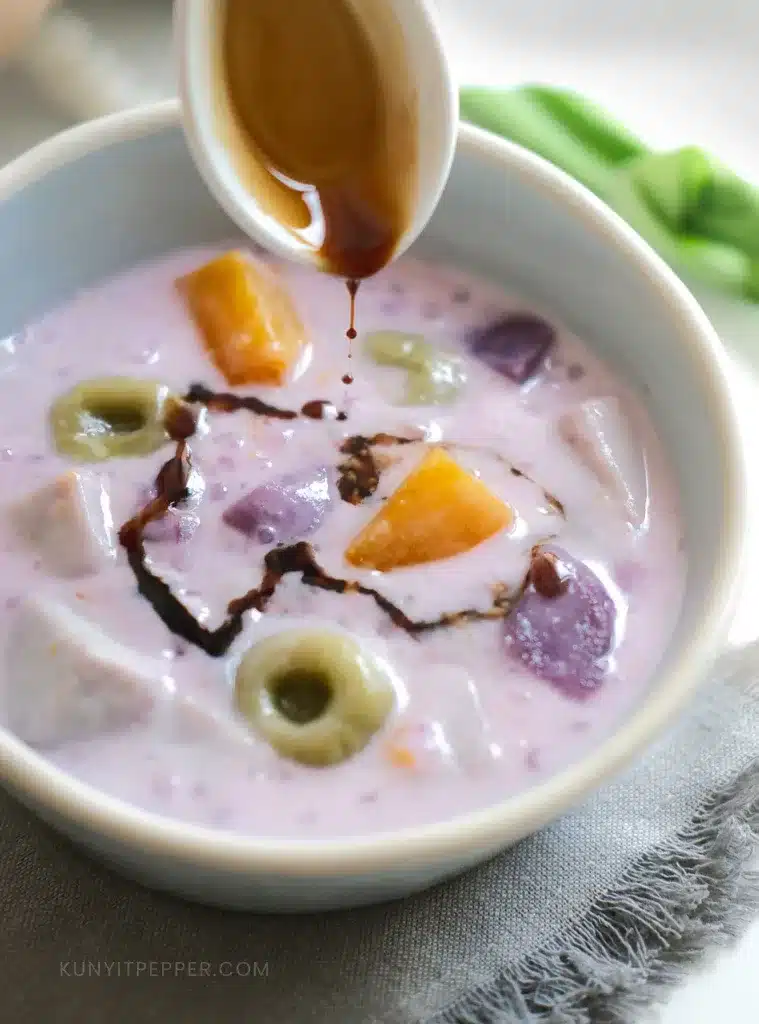
Commonly known as a coconut milk sago dessert or coconut milk sweet potato dessert. This Bubur Cha Cha recipe is a traditional family recipe.
What is Bubur Cha Cha?
Bubur Cha Cha is a Bahasa name for a creamy dessert that combines coconut milk broth with chewy starch bites and starchy vegetables.
The coconut broth is often sweetened with palm sugar and infused with pandan leaves—a classic Southeast Asian flavor.
This coconut milk with root vegetable dessert is famous in several Southeast Asian countries. Malaysia, Singapore, and Brunei share the same name for the dish—Bubur Cha Cha.
Bubur means porridge in Bahasa. While the word ‘Cha Cha’ was unclear, most people say it may derived from the playful character of this dish, which is colorful and chewy.
Indonesia, Thailand, Vietnam, and the Philippines have similar versions of this coconut dessert with slight variations and different names.
This coconut milk dessert can be served warm and cold and is often enjoyed as an evening dessert or in the morning. I prefer it warm because the glutinous bites are the softest in warm soup.
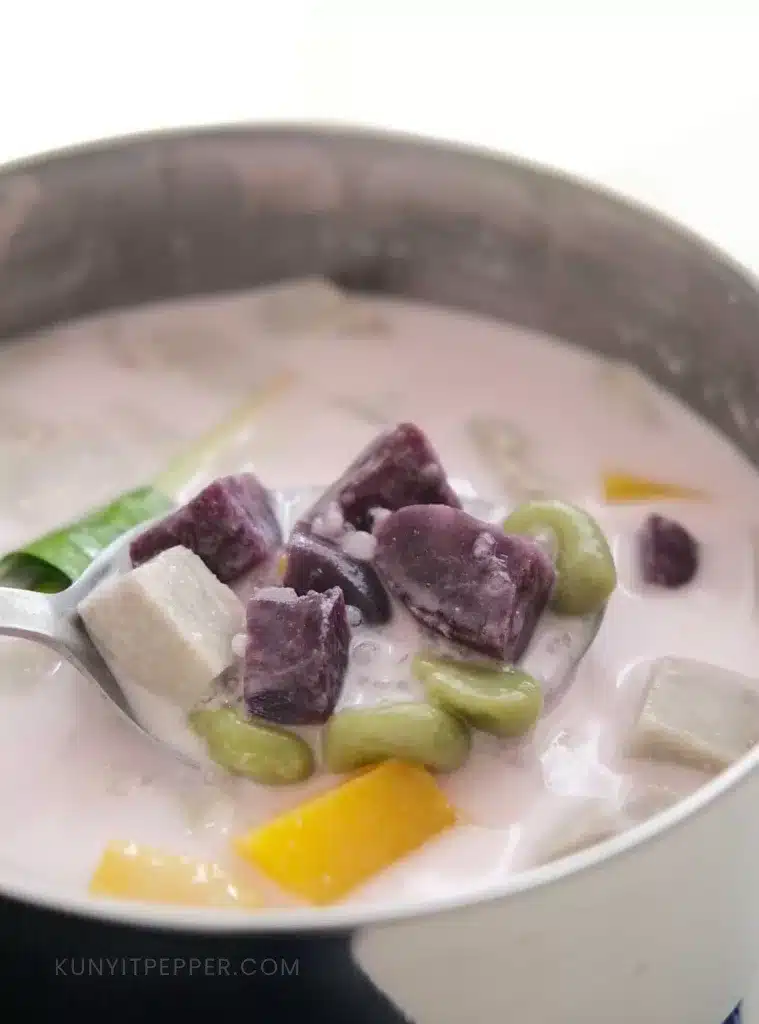
A well-balanced, energy-boosting dessert packed with antioxidants.
This Bubur Cha Cha recipe goes beyond just flavor. It’s a nutritiously hearty dessert with a playful mix of textures and colors that brings a joyful experience to every bite.
- Loaded with complex carbs, these starchy vegetables offer a fiber boost that gives steady energy and helps prevent blood sugar spikes.
- Each colorful ingredient, from the vanilla-ish sweetness of taro to the tender chew of glutinous pandan bites, offers unique antioxidant and anti-inflammatory benefits.
- The recipe uses real ingredients – no artificial coloring or preservatives.
- A filling and satisfying sweet snack, perfect for a quick energy boost or a cozy dessert on a cold rainy day.
✏️ Antioxidants – Natural substances that help protect cells from damage, potentially reducing the risk of chronic diseases.
About this Bubur Cha Cha Recipe
There are three parts of Bubur Cha Cha. The vegetables, the glutinous bites, and the creamy broth.
- Part 1- Vegetables
This Bubur Cha Cha recipe combines sweet potato, taro, and pumpkin. I use purple sweet potato to have a variety of antioxidant colors.
Although pumpkin is not a root vegetable, it’s often classified as one due to its flavor profile and its use in cooking.
✏️ Fun Fact – Pumpkin is a fruit
- Part 2- Glutinous bites
This part makes this dessert more pleasurable to chew and is often colorful.
In this recipe, the glutinous bites are made from scratch, using glutinous rice flour and pandan extract (a blend of pandan leaves with water) as a natural coloring that also adds flavor.
- Part 3-Creamy broth
The creamy broth is made from coconut milk, palm sugar, water, and a bit of salt, simmered with pandan leaf (made into a knot) to infuse the aroma.
This recipe requires a separate simple prep for palm sugar. Giving you the freedom to control your sugar.
Ingredients to make Bubur Cha Cha Recipe
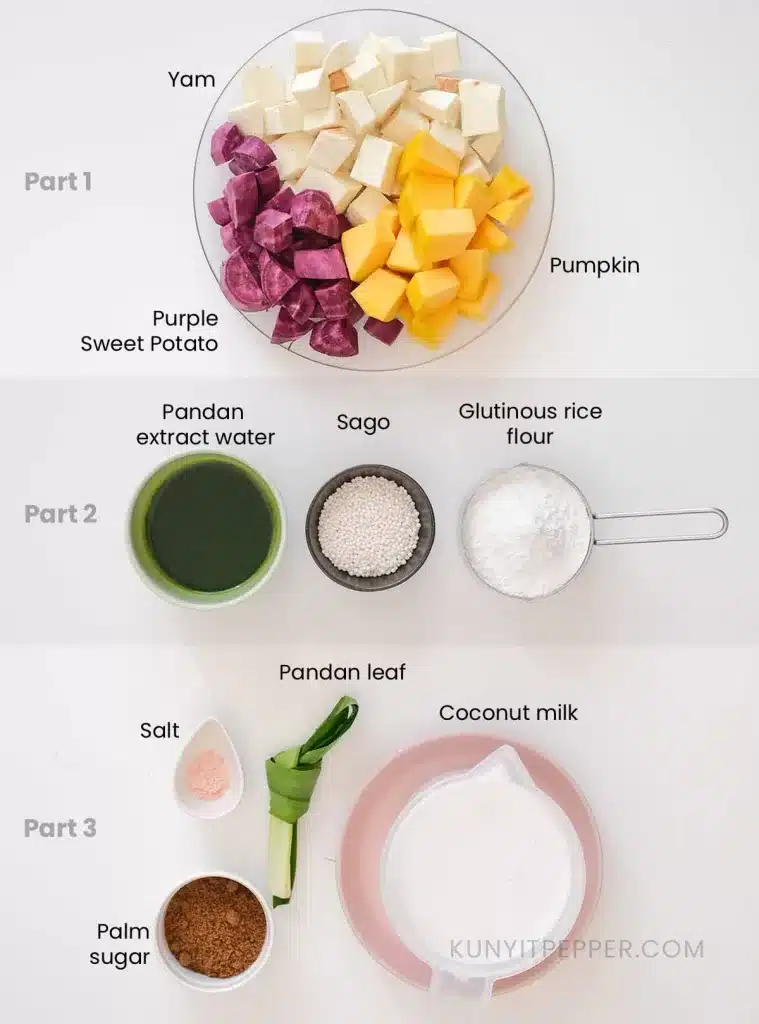
Creamy broth
- Coconut milk—I’m using fresh coconut milk in this recipe. It has a milder taste and is sweeter than the one sold in the box.
Feel free to use coconut cream if it is more convenient. Due to its thickness, reduce it by half and replace it with water to thin the broth.
- Pandan leaves—Pandan is the vanilla essence of Southeast Asian desserts due to its aromatic qualities. Do not skip this ingredient for a full, aromatic, and authentic flavor. I use fresh pandan leaves to make the glutinous bites and for the broth.
✏️ Fresh pandan leaves offer anti-inflammatory benefits. It is used in traditional medicine, including Ayurvedic treatment. The plant substance in pandan has been shown to manage blood sugar levels, relieve joint pain, treat sore throats, aid digestive issues, and many more.
- Palm sugar—Use a dark brown type of palm sugar due to its distinct toffee flavor. It may known by different name—gula melaka/ gula merah (Malaysia & Singapore), gula apong (Brunei), gula aren (Indonesia)).
Chewy bites
- Glutinous rice flour—Also known as Mochi flour, is used to make Japanese Mochi. Some variations use tapioca starch and rice flour, so you can substitute that too.
I like using glutinous rice flour due to its soft, jelly-ish and glutinous texture. Plus it’s a family recipe.
- Pandan extract—You can make it by blending water and cutting pandan leaves.
Sago
- Sago—Small starchy tapioca pearls extracted from cassava root. Commonly used in Bubur Cha Cha, sago is also used interchangeably with the glutinous chewy bites.
You can use it alongside or instead of the glutinous bites (like in this recipe).
Root vegetables
- Sweet potato—I use purple sweet potatoes due to the antioxidant derived from their purple color (anthocyanin) you can benefit from. You can also use the orange type if that’s what is available.
- Yam—I’m using taro in the recipe, it is traditional and commonly used. You can substitute this with the purple yam as well.
- Pumpkin—Feel free to use any kind of pumpkin. Kabocha, like in this recipe, is commonly used in Southeast Asian cooking.
How to make Bubur Cha Cha Recipe
1.Make the glutinous pandan bites
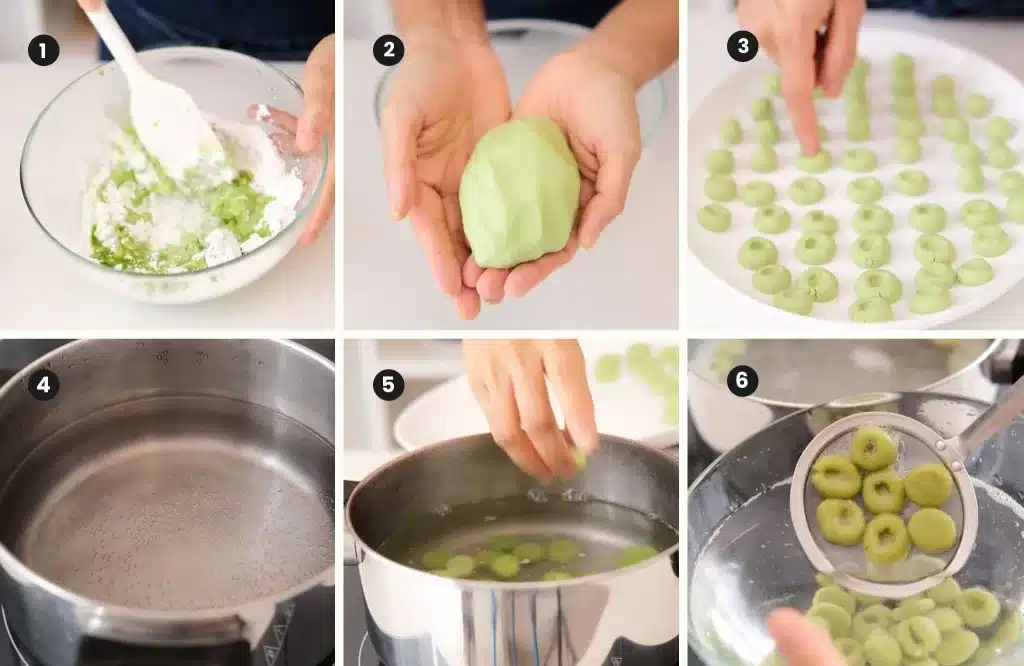
- Combine glutinous rice flour and pandan extract in a bowl.
- Mix until it forms a firm dough (knead if necessary).
- Shape the dough into small bite-size balls and press your index finger in the middle of each ball to flatten it in.
- Bring half a pot of water to a simmer over medium heat in a medium-sized pot.
- Drop the dough balls into the pot (batch by batch) until the bottom of the pot is filled. Boiled until they float.
- Using a strainer, fish out the floating glutinous bites into a bowl filled with water (to prevent them from sticking to each other) and set them aside.
2. Steam the vegetables
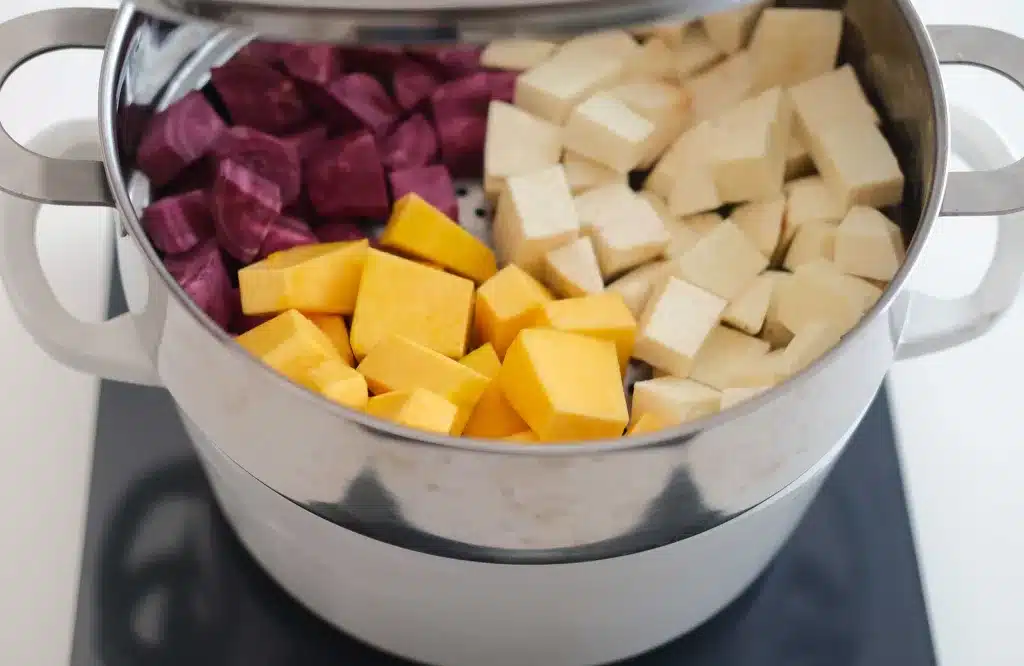
Transfer the vegetables to a steamer basket and steam for 12-15 minutes.
3. Soak the sago

While waiting for the vegetables to steam, soak the sago in water for 10 minutes.
4. Make the broth

In a medium-sized pot, simmer coconut milk with salt and pandan leaf at low heat for about 2 minutes or until the coconut milk is simmered.
Keep stirring to prevent the coconut milk from curdling.
5. Bring everything to cook in a broth
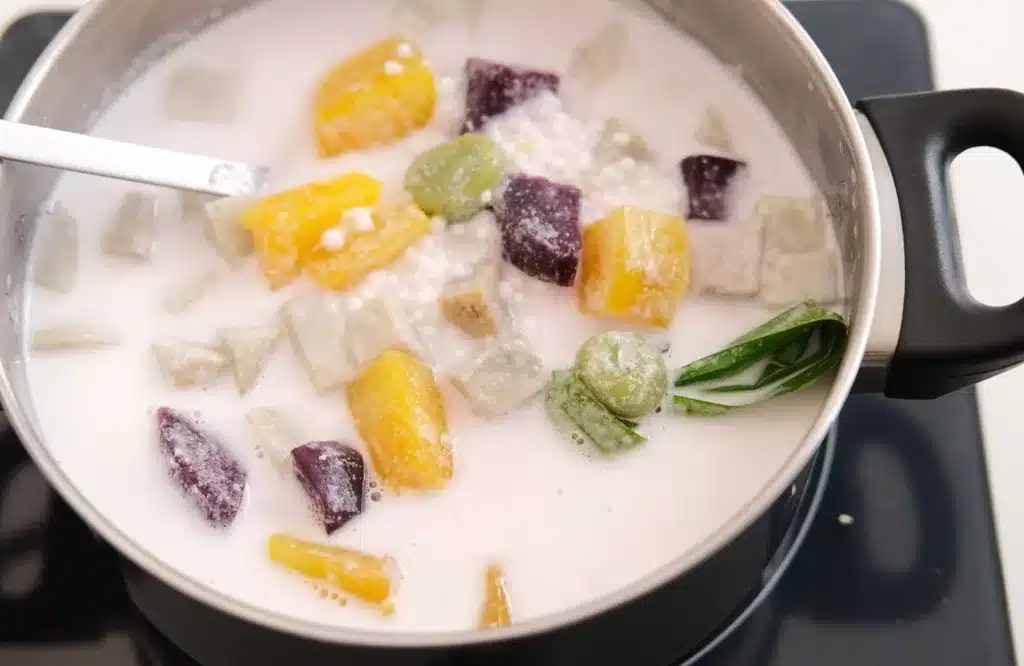
Transfer the sago, glutinous bites, and steamed vegetables into the pot and slowly simmer for 2-3 minutes while stirring them gently on the side.
Turn off the heat and remove the pot from the stove.
6. Mix the palm sugar syrup and serve
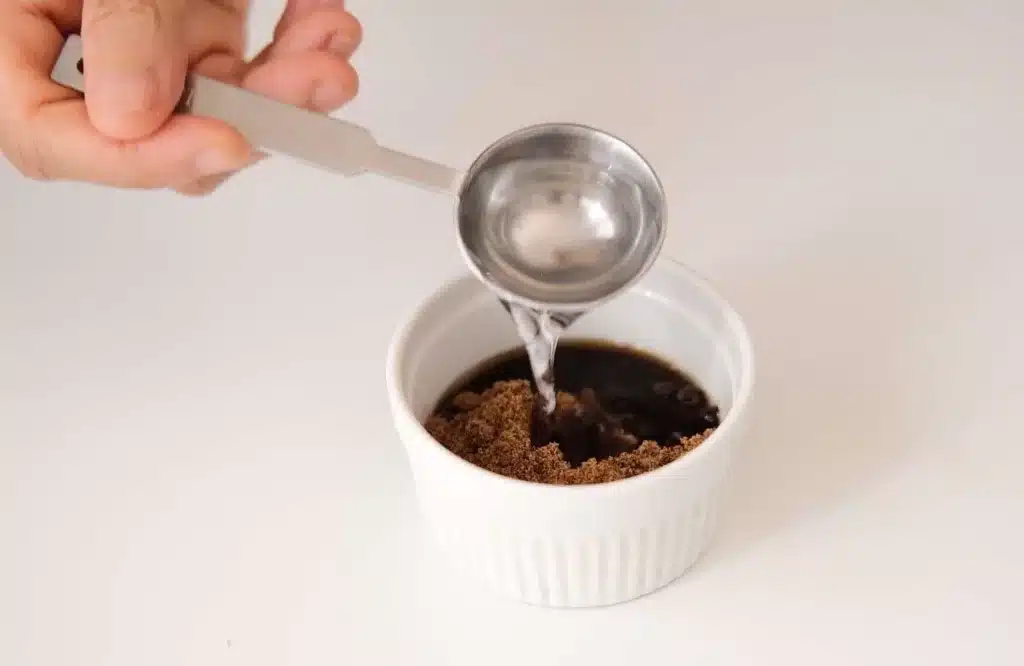
Combine palm sugar with hot water and mix them until it becomes syrup.
Serve the Bubur Cha Cha with a scoop or two of palm sugar syrup while it is still warm.
FAQ
Can I boil the vegetables instead of steaming?
Yes, you can boil the vegetables for 15 minutes. The shape shouldn’t be easily mushy but still firm and soft.
You can also choose to use the boiled water or change it to a new clean water. The difference is that boiled water will make your soup thicker and starchy.
Why my coconut milk curdle?
Coconut milk curdle can caused by a few reasons, such as high heat, long cooking time, and low-quality coconut milk.
Coconut milk is made of fat and water and can separate in high heat. So make sure not to cook it too long (5 minutes is good) and cook at medium to low heat by simmering instead of boiling.
Is it necessary to soak sago before cooking?
Soaking sago prior to cooking depends on the recipe. Some recipes called for soaking the sago first to reduce the cooking time.
How long does it take to cook sago?
Sago will take 10-12 minutes to cook without prior soaking. After 10 minutes of soaking, it can take as little as 2 minutes to cook.
Why do some recipes cook sago separately?
Since sago is starchy, cooking it in a separate pot and later rinsing it to remove the excess starch can reduce the amount of starch in the dish.
It is important to note that the water used to boil the sago can be starchy and thicker.
Can I store Bubur Cha Cha in a fridge?
Yes, you can store Bubur Cha Cha in the fridge for up to three days. Cover it properly to retain its freshness.
The soup will thicken at room temperature and cold temperature; this is normal due to the starch content mixed with the fat from coconut milk. Reheat if necessary.
How to reheat Bubur Cha Cha from the refrigerature?
You can reheat it both in a pan or microwave. Simply add some water to thin the mixture and cook over medium heat while stirring until boiling.
In a microwave, reheat for 3 minutes (depending on your portion) and stir until the added water dissolved.
Other sweet, nutritious recipes you might like
Bubur Cha Cha – Coconut Milk Sago Dessert with Root Vegetables
5
servings20
minutes15
minutesA hearty coconut milk sago dessert with colorful starchy vegetables and glutinous pandan bites.
Ingredients
- Root Vegetable
Purple sweet potato – Skinned and cut into medium dice
Pumpkin – Skinned and cut into medium dice
Yam / Taro – Skinned and cut into medium dice
- Glutinous Pandan Bites
1 cup of glutinous rice flour
1/2 cup of pandan extract water – (300g of pandan leaf blend with 1/2 a cup of water)
- Broth
Coconut milk – (500g freshly grated coconut + 2 and 1/2 cups water) or (1 and 1/2 cups of coconut cream + 1 and 1/2 cups of water)
1/2 tsp salt
Palm sugar syrup – For drizzle (4 Tbsp of palm sugar + 3 tbsp of water)
1 piece of pandan leaf (tie in knot)
- Sagoo
1/4 cup of Sago
Directions
- Check the instructions section above for a visual guide.
- Make the glutinous pandan bites –
1- Combine glutinous rice flour and pandan extract in a medium-sized bowl
2- Mix until it forms a dough.
3- Shape the dough into small bite-size balls and press your index finger in the middle of each ball to flatten it in.
4- Bring half a pot of water to a simmer over medium heat in a medium-sized pot.
5- Drop the dough balls into the pot (batch by batch) until the bottom of the pot is filled. Boiled until they float.
6- Using a strainer, fish out the floating glutinous bites into a bowl filled with water (to prevent them from sticking to each other) and set them aside. - Steam the vegetables – Transfer all cut vegetables to a steamer basket and steam for 12-15 minutes.
- Soak the sago in water – While waiting for the vegetables to steam, soak the sago in water for 10 minutes.
- Make the broth – In a medium-sized pot, simmer coconut milk with salt and pandan leaf at low heat for about 2 minutes or until the coconut milk is simmered. Keep stirring to prevent the coconut milk from curdling.
- Bring everything to cook in a broth – Transfer the sago, glutinous bites, and steamed vegetables into the pot and slowly simmer for 2-3 minutes while stirring them gently on the side.
- Make palm sugar syrup and serve – Combine palm sugar with hot water and mix them until it turn into syrup. Serve the Bubur Cha Cha with a scoop or two of palm sugar syrup and enjoy while it is still warm.
Notes
- Sago and glutinous pandan bites can be used interchangeably or together.
- Since pumpkin is softer than root vegetables, consider cutting it in slightly bigger cubes than the rest.
- If you’re extracting the coconut from scratch, make sure the coconut is at room temperature. When it’s cold, the fat tends to solidify.
- You can also mix the palm sugar with coconut milk while simmering. I find that adding palm syrup separately helps to control the amount of sugar.
🥣 Did you try this recipe? Let me know your thoughts in the comment below.


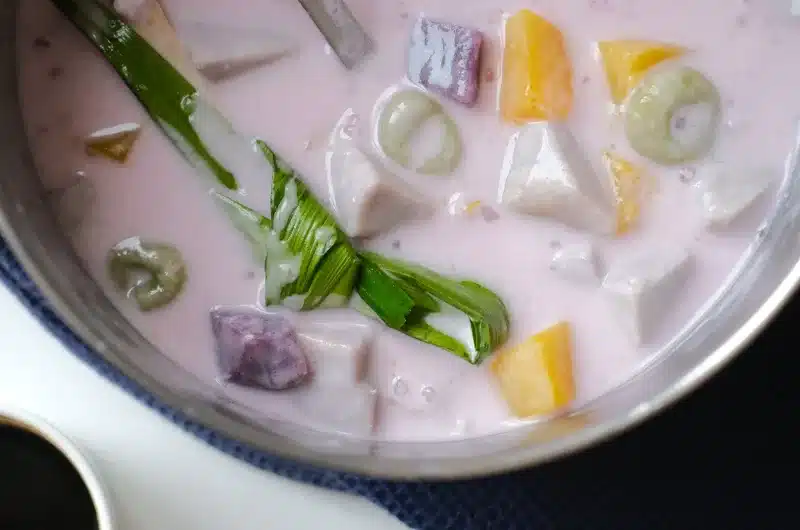





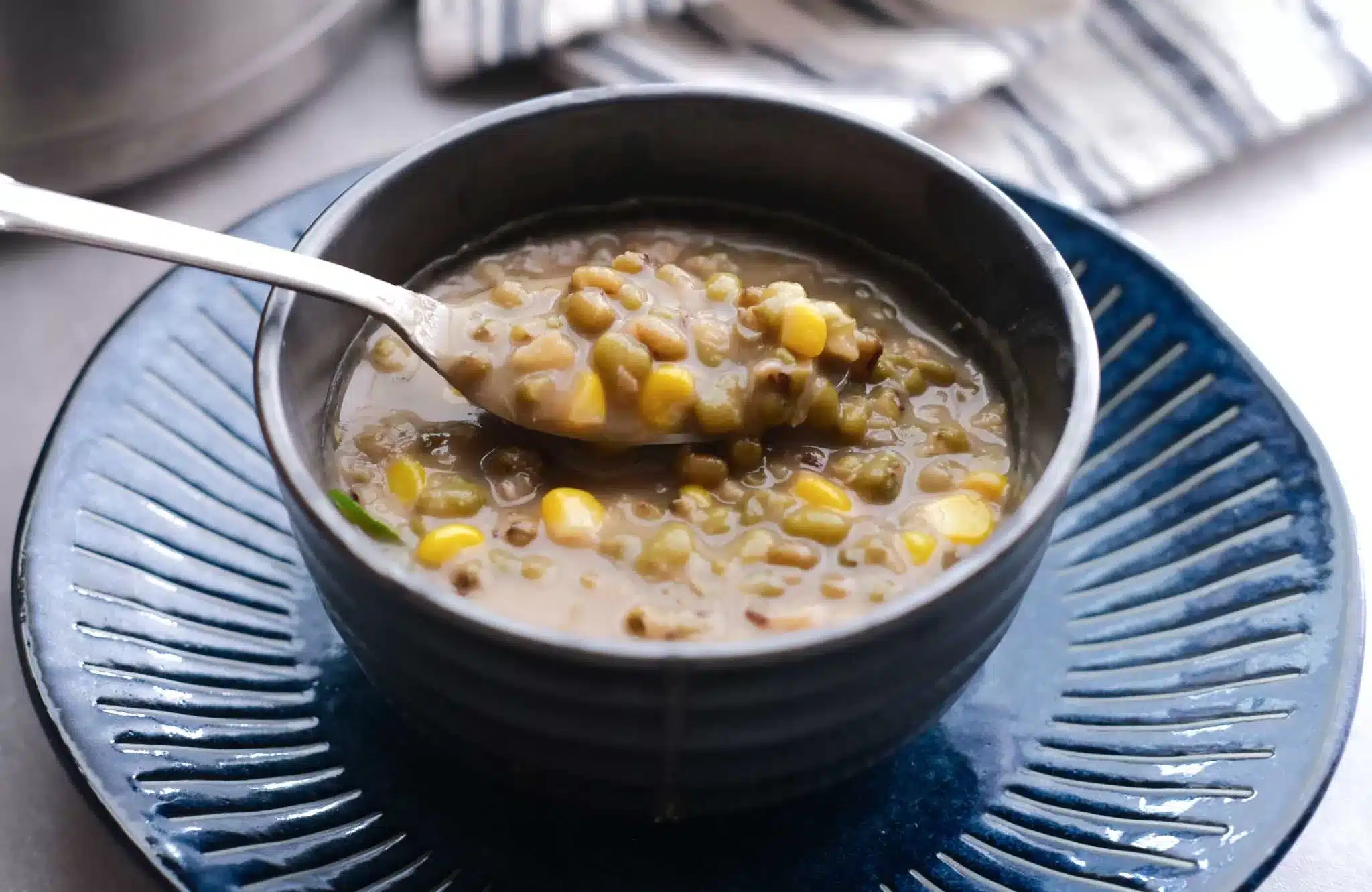
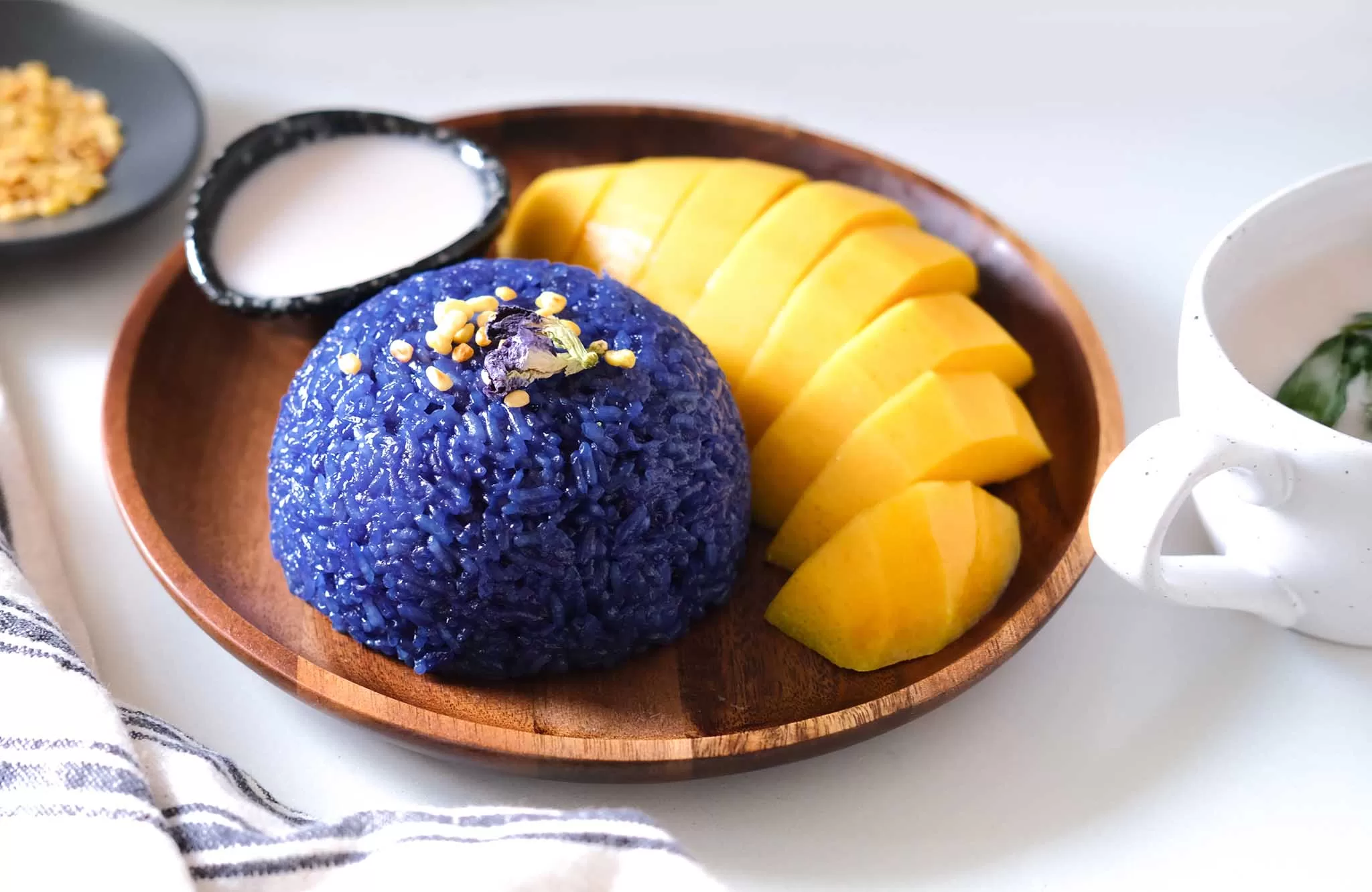

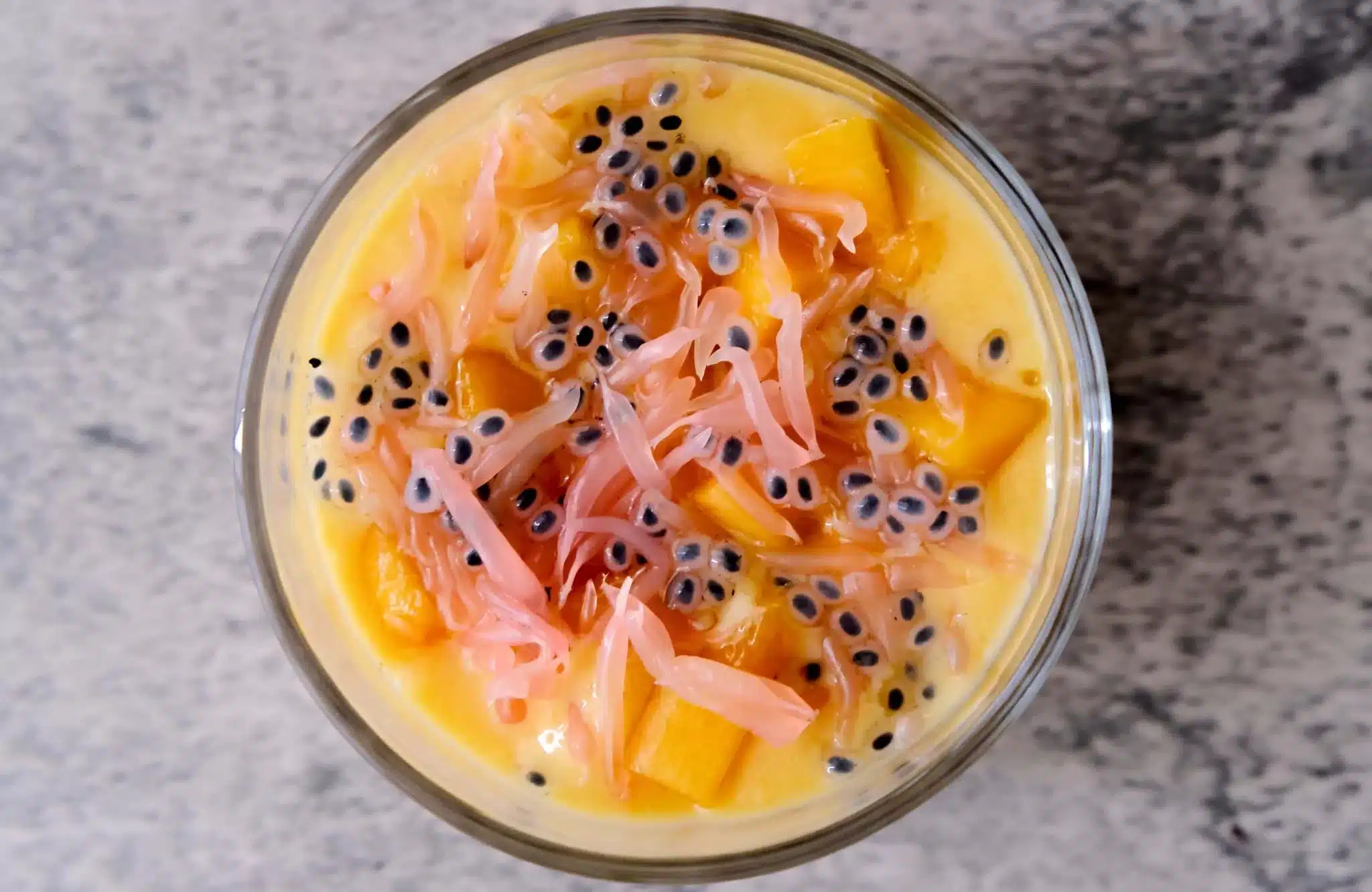
4 Responses
Where do u buy sago?
You can find it at Asian markets/marts in your area. It’s also called tapioca pearl, or you can buy from Amazon here – sago pearl
You didn’t include the amount of sago in the ingredients
Hello, sorry about that and thanks for letting me know. I have added the amount of sago on the recipe card. 🙂